Indigenous activists’ deaths highlight surging Colombia conflict
Confrontations between Indigenous Guard land defenders and FARC rebel dissidents are escalating, experts say.
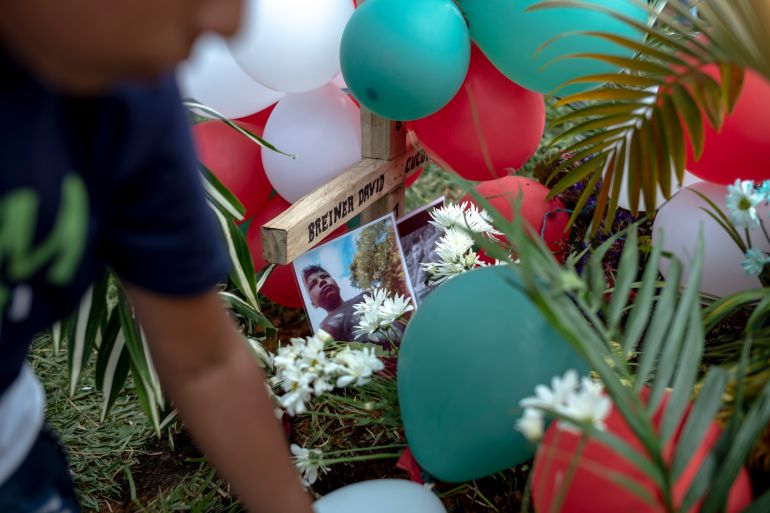
This article was produced in partnership with the Pulitzer Center on Crisis Reporting.
Las Delicias, Cauca department, Colombia – Children sobbed and hugged each other as men took turns shovelling earth onto a coffin in the hilltop cemetery in this small village in southwestern Colombia.
Keep reading
list of 3 itemsNearly 150 activists killed in Colombia in 2021: Rights ombudsman
Colombia can’t resume coca aerial spraying for now, court rules
A sombre atmosphere, spurred by the sound of musicians playing flutes and drums, hung over the Indigenous Nasa community of Las Delicias, which has been in mourning since the death of 14-year-old Breiner David Cucuname last month.
Members of other Indigenous communities travelled on large buses for several hours to remember the young environmental activist, who died in a confrontation between Revolutionary Armed Forces of Colombia (FARC) rebel dissidents and the Cauca region’s so-called Indigenous Guard.
“All of this has happened due to competition over territorial control to carry out drug trafficking,” said Samuel Cucuname, a member of the guard and Breiner’s father, standing beside his son’s grave at the burial, which the Nasa people refer to as “planting” someone back to the earth.
Covered in red and green adornments – the colours of the Regional Indigenous Council of Cauca (CRIC) – Cucuname described his son as “a quiet boy” who was “decisive” and “kept his word”.
“Innocent people die,” he told Al Jazeera, “because as Indigenous guards we defend our land from armed groups.”
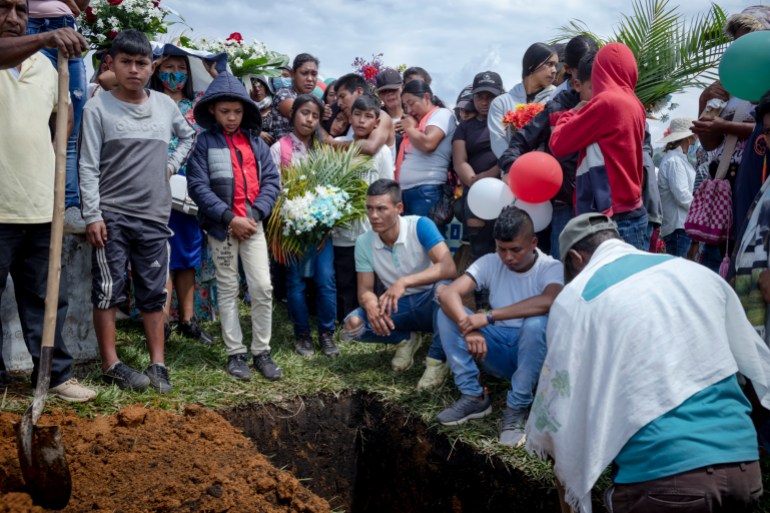
The guard
The Indigenous Guard – or Kiwe Thegnas in the Nasa Yuwe language – is a grassroots network of Indigenous men, women and children who volunteer to defend their ancestral territories. It originated in Colombia’s violence-ridden Cauca province and began to operate as an organised force in 2001, during a peak in armed conflict.
Without weapons of their own, members of the guard have confronted a wide variety of armed groups in Colombia, from the now-defunct leftist FARC rebels to right-wing paramilitaries and the Colombian army.
Members of the guard carry a baton decorated with a red-and-green ribbon that symbolises the power they have been granted by the community. They hold weekend schools for youth, teaching them not only about traditional Nasa customs, but most importantly about how to protect themselves and their land from violence and environmental damage.
Guard members say their main threat today comes from groups of dissident FARC rebels who disagree with a 2016 peace deal that saw the group demobilise, bringing an end to decades of fighting, and have since picked up arms again.
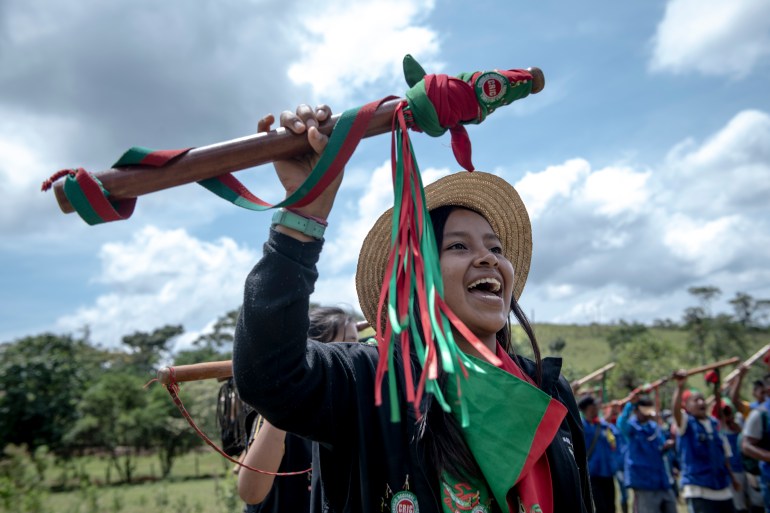
Protecting Indigenous lands from FARC dissidents and other groups who wreak havoc on the environment through illegal gold mining and the cultivation of coca – the raw ingredient for cocaine – is now the guard’s main purpose.
Experts say the dissidents – who number in the hundreds – are also trying to enforce social control over communities in parts of Colombia where they are fighting for control of resources – leading to increased conflict in those areas.
Elizabeth Dickinson, a senior researcher on Colombia at the International Crisis Group (ICG), said the guard has been a pillar of stability in Cauca, maintaining Indigenous traditions and cultural life, and holding a key leadership role – the latter of which the FARC dissidents now are seeking to take over.
“What they’ve been trying to do is penetrate the social cohesion and make themselves not only economic leaders who provide economic opportunities, but also people who give directionality to the community,” Dickinson told Al Jazeera.
“The dissidents view them [the guard] as their primary enemy to establishing themselves … within the community,” she said. “That’s the conflict that we’re seeing here. It’s not about territorial control any more; it’s gone much deeper than that.”
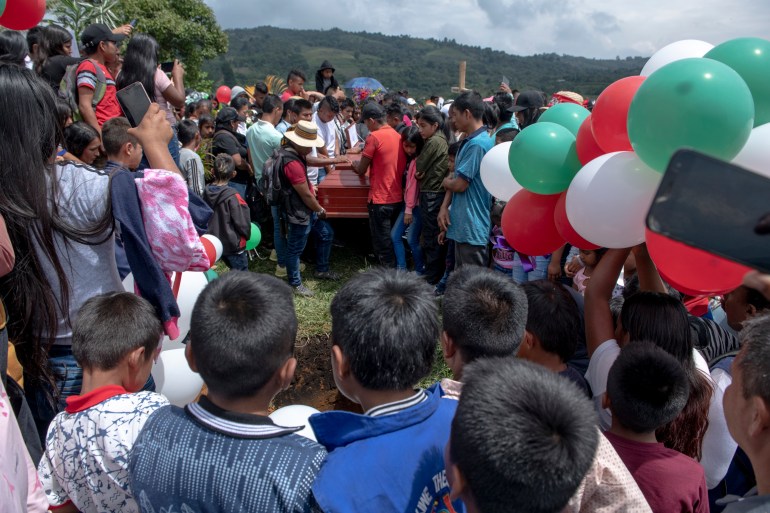
Cucuname’s death
The recent deaths of prominent guard members, including Cucuname, have underscored that ongoing battle.
In mid-January, a senior member of the guard, Albeiro Camayo, told Al Jazeera about the circumstances that led to the teenager’s death. Camayo said he and other residents of Las Delicias, including Cucuname, on January 14 approached eight armed FARC dissidents who claimed that the village was under their control.
After a heated debate, Camayo said the situation became tense and the dissidents attacked the members of the guard, first with grenades and then rifles. The attack resulted in the death of Cucuname and another guard member, Guillermo Chacame, while one of Camayo’s brothers was wounded after being hit by shrapnel. Cucuname’s father, Samuel, said his son was killed by gunfire.
Ten days after the attack, on January 24, Camayo was also shot and killed by FARC dissidents, the guard said. The dissidents said Camayo was killed in an “armed confrontation”. For months, the dissidents had accused Camayo and another of his brothers – who was killed in a confrontation with dissidents in November of last year – of carrying weapons and collaborating with the Colombian army – claims they and the guard had vehemently denied.
Camayo’s death has spurred a huge uproar and anger within the community, and garnered national attention, with Dickinson at ICG calling it “emblematic of a strong conflict that is on the way for social control in northern Cauca”.
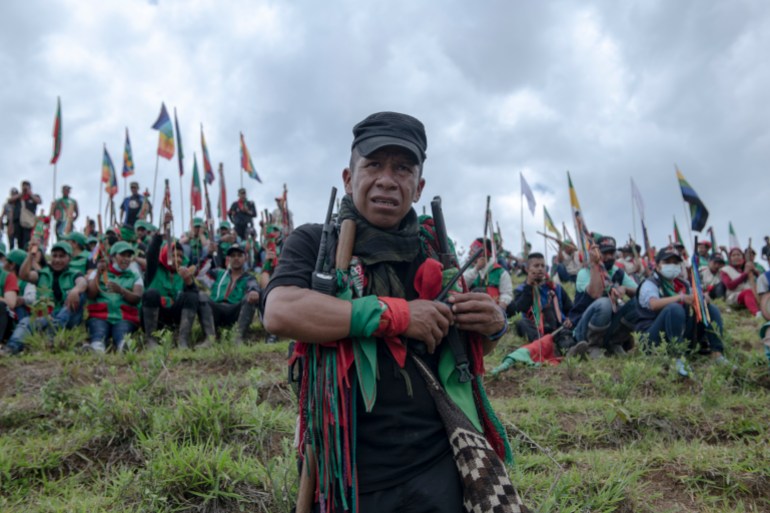
Surge in violence
Amnesty International raised concern this week over the deaths of at least 20 human rights defenders across the Americas region in January – including 13 in Colombia alone, according to the Institute for Development and Peace Studies (INDEPAZ).
“The protection of Indigenous, campesino and Afro-descendant communities in Colombia is ineffective because it does not address the structural causes of violence and often occurs without the proper participation of those at risk,” Erika Guevara-Rosas, Amnesty’s Americas director, said in a statement on Wednesday.
“Defenders of communities at risk are constantly unprotected, and threats, attacks and killings are constant in the country considered the most dangerous in the world for defending human rights.”
While Colombian President Ivan Duque said Cucuname’s death “fills us with sadness” and pledged to work alongside the prosecutor’s office to shed light on what happened, his government has been widely criticised for what critics say have been lacklustre efforts to protect environmental defenders and social activists across the country.
The Colombian government did not respond directly to Al Jazeera’s questions about the recent deaths in Cauca. Instead, a spokesperson pointed to the government’s Protection Unit, which supports at-risk environmental defenders in the country by providing them with a “protection route” out of harm’s way. The unit says on its website that it can take up to three months for such a plan to be issued.
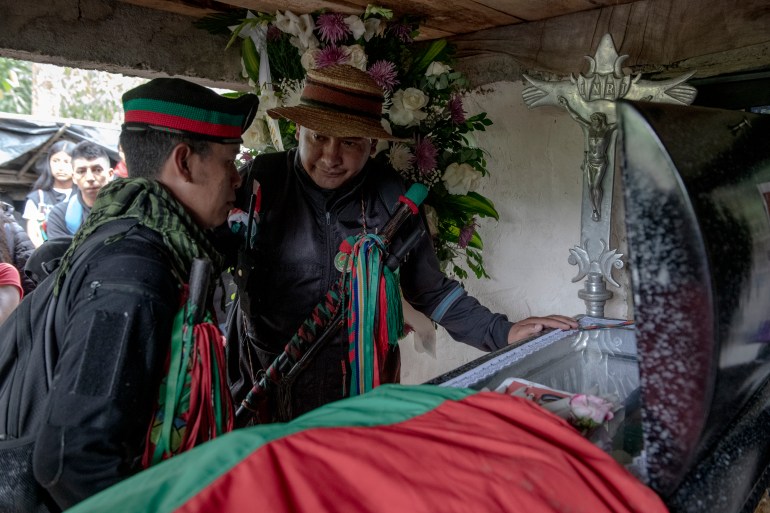
According to a 2021 report (PDF) by INDEPAZ, at least 611 environmental defenders have been killed since the signing of the peace agreement in Colombia in 2016. Of these, 332 were Indigenous, the report said, and 204 of the killings took place in Cauca.
This year so far, 12 Indigenous people – including three members of the guard – have been killed in Cauca, according to Juan Camayo Diaz, coordinator of Tejido de Defensa de la Vida, an Indigenous human rights organisation in the province.
The situation in the region is “one of the most concerning in Colombia”, said Juan Pappier, a senior Americas researcher at Human Rights Watch. “Today many of the municipalities in the region face even higher levels of homicides than immediately before the peace process. That’s a tragedy that requires an urgent re-think of the government’s security and protection strategies,” Pappier told Al Jazeera.
‘Legacy will live on’
Amid the ongoing fight for control, FARC dissidents have consolidated their hold on the eastern part of northern Cauca under the command of the Dagoberto Ramos Mobile Column. On the western side, they operate under the command of the Jaime Martinez Mobile Column.
The road to the small village of Las Delicias led Al Jazeera through dissident territory, where giant posters of the Jaime Martinez Mobile Column were hammered into the ground on wooden poles. Spray-painted FARC acronyms were frequently seen on walls of houses in tiny villages en route.
Meanwhile, sweeping valleys of illegal coca plantations were in full view for several kilometres along the dramatic western Andean mountain range road – a sign that Colombian government forces had not ventured into the area for some time. Locals in Las Delicias said the coca crops started to appear in the years after the peace deal and have continued to expand.
Local Indigenous communities have also raised alarm over frequent disappearances of children. Many are believed to have been recruited into the ranks of armed groups, said Edgar “Tumi” Tumina, a member and ex-coordinator of the Indigenous Guard in Toribio, another violence-plagued town in Cauca.
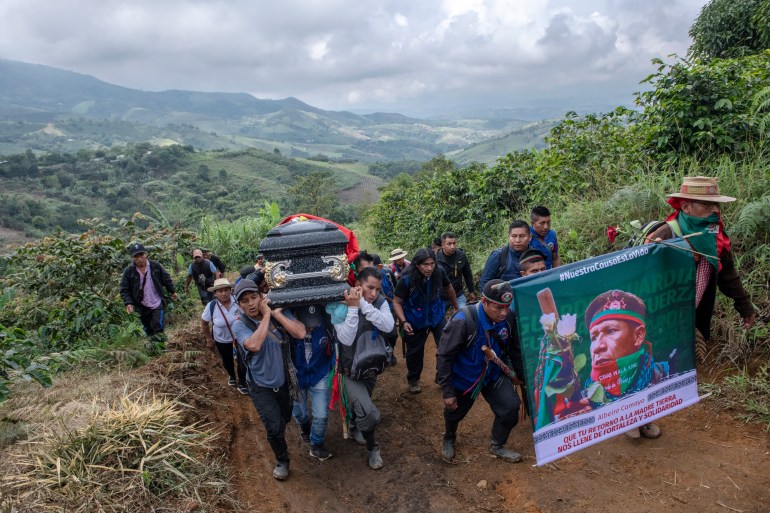
But Tumina, whose own car was attacked by gunmen in 2019, said few disappearances are reported. “Out of fear, people do not report the incidents, so as Indigenous Guard [members] we are also not sure exactly how much [recruitment is] happening,” he said. “Around here, those who speak out get killed.”
Back in Las Delicias, Samuel Cucuname, Breiner’s father, said he also has received death threats from FARC dissidents. The day after his son’s funeral, Cucuname and his family fled the village after receiving fresh threats from the dissident rebels, a contact close to the family told Al Jazeera.
But Samuel said the struggle to protect Indigenous territories will continue – no matter the risks.
“[Breiner] was part of the Indigenous Guard’s school for young people and he’ll continue to be part of it, because his legacy will live on,” he told Al Jazeera minutes after burying his son. “At just 14 years old, he is leaving behind a huge legacy and he’s led the way for other young people who want to become part of the guard – to protect life and their territory.”